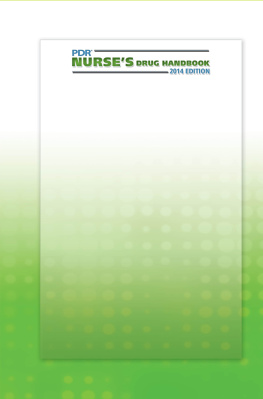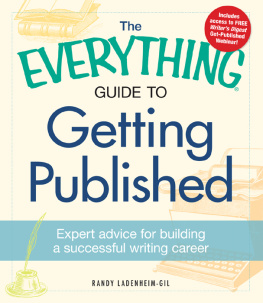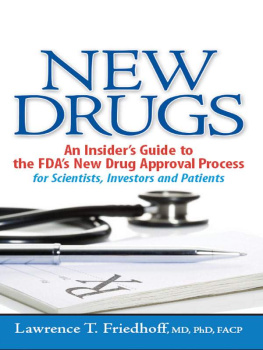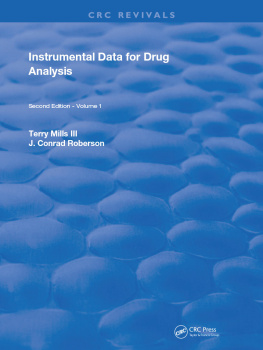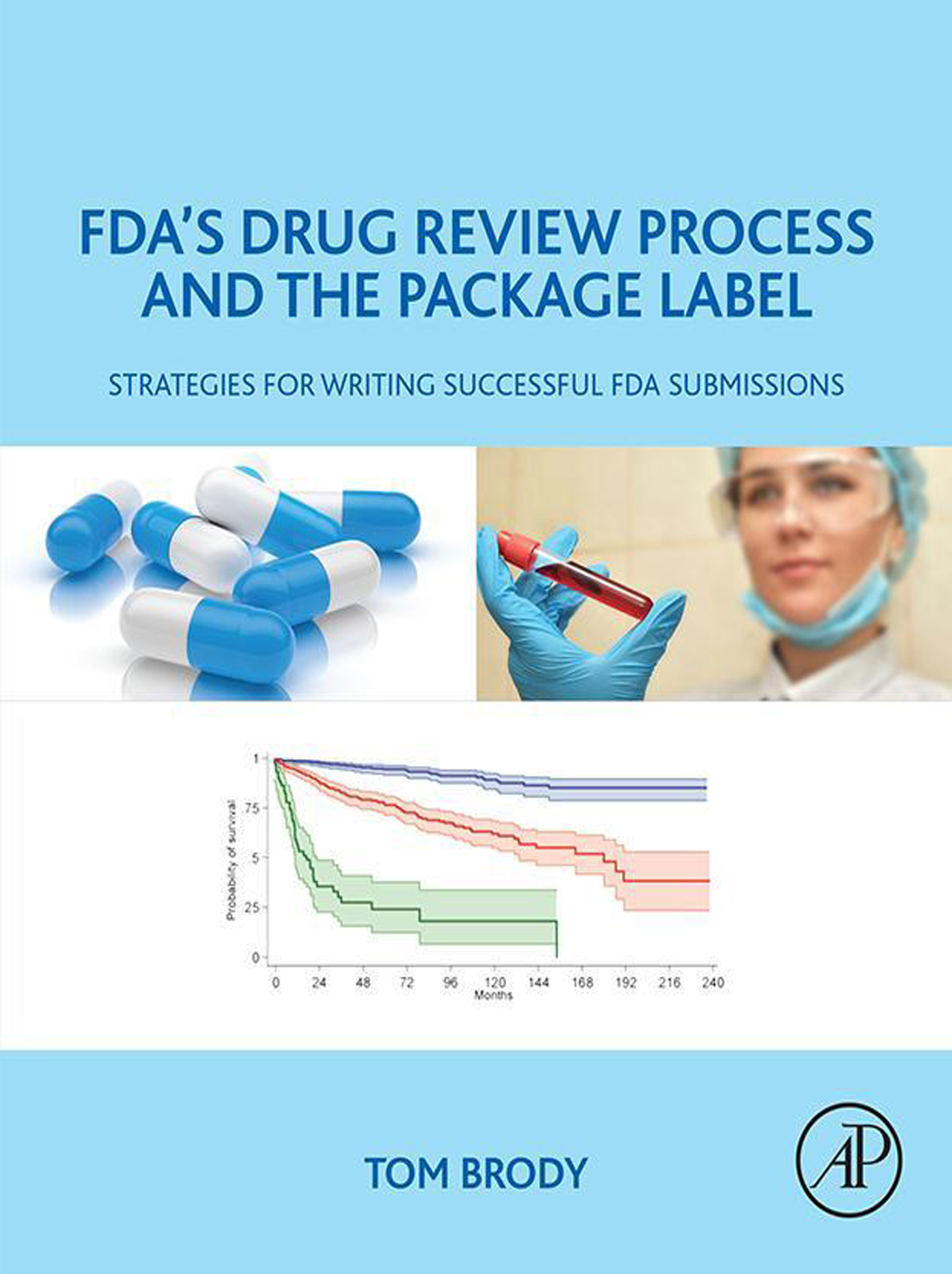Table of Contents
List of tables
- Tables in Chapter 1
- Tables in Chapter 3
- Tables in Chapter 4
- Tables in Chapter 5
- Tables in Chapter 6
- Tables in Chapter 7
- Tables in Chapter 8
- Tables in Chapter 9
- Tables in Chapter 10
- Tables in Chapter 11
- Tables in Chapter 12
- Tables in Chapter 13
- Tables in Chapter 14
List of illustrations
- Figures in Chapter 1
- Figures in Chapter 3
- Figures in Chapter 4
- Figures in Chapter 5
- Figures in Chapter 6
- Figures in Chapter 7
- Figures in Chapter 8
- Figures in Chapter 9
- Figures in Chapter 10
- Figures in Chapter 11
Landmarks
Table of Contents
FDAs Drug Review Process and the Package Label
Strategies for Writing Successful FDA Submissions
Tom Brody

Copyright
Academic Press is an imprint of Elsevier
125 London Wall, London EC2Y 5AS, United Kingdom
525 B Street, Suite 1800, San Diego, CA 92101-4495, United States
50 Hampshire Street, 5th Floor, Cambridge, MA 02139, United States
The Boulevard, Langford Lane, Kidlington, Oxford OX5 1GB, United Kingdom
Copyright 2018 Elsevier Inc. All rights reserved.
No part of this publication may be reproduced or transmitted in any form or by any means, electronic or mechanical, including photocopying, recording, or any information storage and retrieval system, without permission in writing from the publisher. Details on how to seek permission, further information about the Publishers permissions policies and our arrangements with organizations such as the Copyright Clearance Center and the Copyright Licensing Agency, can be found at our website: www.elsevier.com/permissions.
This book and the individual contributions contained in it are protected under copyright by the Publisher (other than as may be noted herein).
Notices
Knowledge and best practice in this field are constantly changing. As new research and experience broaden our understanding, changes in research methods, professional practices, or medical treatment may become necessary.
Practitioners and researchers must always rely on their own experience and knowledge in evaluating and using any information, methods, compounds, or experiments described herein. In using such information or methods they should be mindful of their own safety and the safety of others, including parties for whom they have a professional responsibility.
To the fullest extent of the law, neither the Publisher nor the authors, contributors, or editors, assume any liability for any injury and/or damage to persons or property as a matter of products liability, negligence or otherwise, or from any use or operation of any methods, products, instructions, or ideas contained in the material herein.
British Library Cataloguing-in-Publication Data
A catalogue record for this book is available from the British Library
Library of Congress Cataloging-in-Publication Data
A catalog record for this book is available from the Library of Congress
ISBN: 978-0-12-814647-7
For Information on all Academic Press publications visit our website at https://www.elsevier.com/books-and-journals

Publisher: Mica Hayley
Acquisition Editor: Kattie Washington
Editorial Project Manager: Kathy Padilla
Production Project Manager: Mohana Natarajan
Cover Designer: Greg Harris
Typeset by MPS Limited, Chennai, India
Dedication
To Dawnia and Shideh
Biography
The author received his PhD from the University of California at Berkeley in 1980, and conducted postdoctoral research at the University of Wisconsin-Madison and also at the University of California at Berkeley. The author has 15 years of pharmaceutical industry medical writing experience, acquired at Schering-Plough, Cerus Corporation, SciClone Pharmaceuticals, and Athena Neurosciences (Elan Pharmaceuticals), and has contributed to FDA submissions for the indications of multiple sclerosis, melanoma, head and neck cancer, hepatocellular carcinoma, idiopathic thrombocytopenic purpura, and hepatitis C virus. The author has published two editions of the textbook, Clinical Trials: Study Design, Endpoints and Biomarkers, Drug Safety, and FDA and ICH Guidelines. This book provides background information for the topics in the present book, but the information in these two books overlaps by only 5%.
The author has 15 years of training and experience in the Code of Federal Regulations as it applies to pharmaceuticals. Shortly before entering the pharmaceutical industry, he published two editions of Nutritional Biochemistry, which describes the clinical features, diagnosis, and treatment of metabolic diseases.
Brody T. Clinical Trials study design, endpoints and biomarkers, drug safety, and FDA and ICH guidelines. 2nd ed. New York, NY: Elsevier, Inc. 2016.
Brody T. Nutritional Biochemistry. 2nd ed. New York, NY: Elsevier, Inc. 1999.
Brody T, Stokstad ELR. Folate oligoglutamate: amino acid transpeptidase. J. Biol. Chem. 1982;257:142719.
Brody T, et al. Folate pentaglutamate and folate hexaglutamate mediated one-carbon metabolism. Biochemistry 1982;21:27682.
Brody T, Stokstad ELR. Nitrous oxide provokes changes in folylpenta- and hexaglutamates. J. Nutr. 1990;120:7180.
Brody T, Stokstad ELR. Incorporation of the 2-ring carbon of histidine into folylpolyglutamate coenzymes. J. Nutr. Biochem. 1991;2:4928.
Brody T, et al. Separation and identification of pteroylpolyglutamates by polyacrylamide gel chromatography. Analyt. Biochem. 1979;92:5019.
Brody T. The influence of folate binding proteins on 1-carbon metabolism. Pteridines 1989;1:15965.
Brody T, et al. Rat brain folate identification. J. Neurochem. 1976;27:40913.
Brody T, Shane B. Folic acid. In: Rucker RB, Suttie JW, McCormack DB, Machlin LJ, editors. Handbook of the vitamins. 3rd ed. New York, NY: Marcel Dekker, 2001. pp. 42762.
Brody T, Suttie JW. Glutamate carboxylase: assays, occurrence, and specificity. Methods Enzymol. 1984;107:55263.
Brody T, Suttie JW. Evidence for the glycoprotein nature of vitamin K-dependent carboxylase from rat liver. Biochim. Biophys. Acta. 1987;923:17.
Brody T. Multistep denaturation and hierarchy of disulfide bond cleavage of a monoclonal antibody. Analyt. Biochem. 1997;247:24756.
Brody T, et al. Human damage-specific DNA binding protein p48 subunit mRNA. GenBank Accession No. U18299; 1995.
Keeney S, Eker AP, Brody T, et al. Correction of the DNA repair defect in xeroderma pigmentosum group E by injection of a DNA damage-binding protein. Proc. Natl Acad. Sci. 1994;91:40536.
Dualan R, Brody T, Keeney S, et al. Chromosomal localization and cDNA cloning of the genes (DDB1 and DDB2) for the p127 and p48 subunits of a human damage-specific DNA binding protein. Genomics. 1995;29:629.
Abbreviations and Definitions
ADR adverse drug reaction
AE adverse event
agonist An agonist is a drug or naturally occurring ligand that binds to and stimulates (or activates) a receptor. The fact that a drug binds to a receptor, without more, does not imply that it is an agonist or an antagonist.


